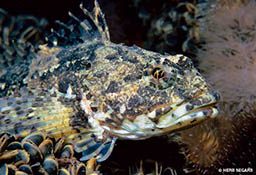
It was one of those wonderful days to be underwater — good visibility, no current and calm seas. I cruised the outskirts of the wreck until I found the photo opportunity I was looking for: My friend Gerry was hovering intently, taking photos at the roof of the Lana Carol’s pilothouse. This 71-foot-long scallop boat sank in a storm on Halloween 1976 and now sits upright on a sandy bottom in 90 feet of water. I adjusted my camera settings and snapped the photo of Gerry and the pilothouse. The image was just as I had seen it in my mind’s eye, but I received an unexpected bonus. Gerry’s flash had a sensor that caused it to fire when it detected light from another flash. Mine was bright enough to trigger the sensor, and that added a nice element to the image. I chuckle to myself when people remark how lucky I was to catch the photographer just as he took a photo.
Underwater photography is just one of many ways to enjoy diving off New Jersey’s coast. With thousands of artificial reefs, including shipwrecks, rock piles and more, New Jersey offers something for every diver. Thanks to the bottom conditions off the coast, the state has a surprising diversity of marine life. The seafloor is flat, sandy and desertlike. There is life in this desert, but it is sparse. The abundant wrecks and other artificial reefs are oases: They provide substrates for marine organisms and safe havens for reef fish. These fish provide food sources for larger pelagic species.
Harvesting
Spearfishermen delight in catches of black sea bass, tautog (blackfish), red hake, goosefish (monkfish) and both summer and winter flounder. The Mohawk, a 387-foot passenger liner that lies in 80 feet of water about eight miles out of Manasquan Inlet, is one popular spot for spearfishing. It sank in 1935 after colliding with the Norwegian tanker Talisman. The Mohawk was later blown apart and wire dragged by the Navy to prevent it from being a hazard to navigation. The Mohawk covers a large area of the ocean bottom, and it is easy for several dive boats to be on the site at the same time. It is also a popular spot for lobster divers.
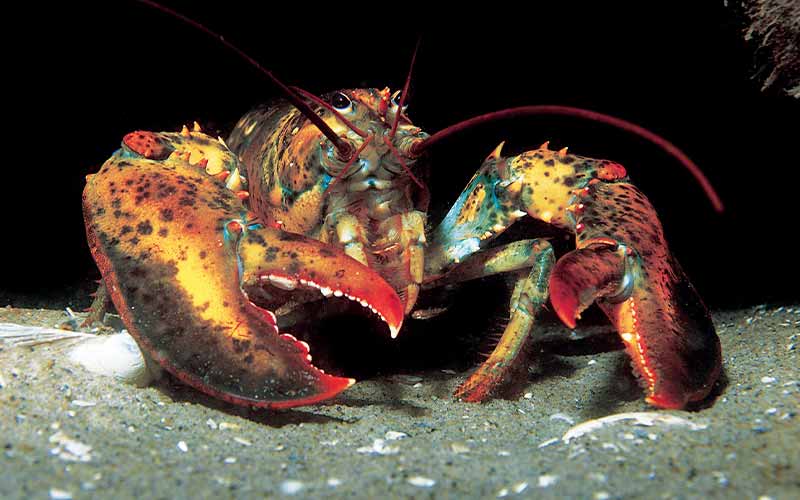
Lobster hunting is a New Jersey dive specialty, and it takes as much skill as spearfishing. Catching a North American lobster is an art. A diver plunges his hand into a hole, tries to grab a lobster without being pinched and then has to pull out the crustacean. Frequently, the lobster wins the battle. Boat captains have their own favorite spots for lobsters, and these are usually secret spots whose locations are protected dearly. The “Sea Girt Wreck,” named after the town of Sea Girt, N.J., can be good for lobsters even though it is dived often. The wreck sits in 85 feet of water and consists of two parallel wooden walls about three to four feet high with many openings for lobsters and crabs.
Divers looking for sea scallops must venture into deeper waters (usually 90 feet or more) and be aware of the associated time constraints. Scallops are fun; they look like Pac-Man when they swim. It is not unusual to find scallops around the wreck of the Stolt Dagali, which lies in 130 feet of water about 20 miles east of Manasquan Inlet. The Stolt is a 582-foot tanker that was cut in half by the Israeli passenger liner Shalom on Thanksgiving Day 1964. The stern sank, but the bow stayed afloat, was towed to port and salvaged.
Blue mussels are tasty, and they are the easiest seafood for divers to harvest. My favorite site for blue mussels is the Dykes, also known as the “Five-Masted Schooner” or the “Steel Schooner.” It lies in 65 feet of water on the Sea Girt artificial reef site. The bow section is usually blanketed with mussels, and divers fill mesh bags with them and use lift bags to bring them to the surface. Mussels collected high off the sandy bottom are grit-free. Harvesters often tow the mesh bags behind the boat on the way home; this tumbles the mussels and cleans the exterior of their shells.
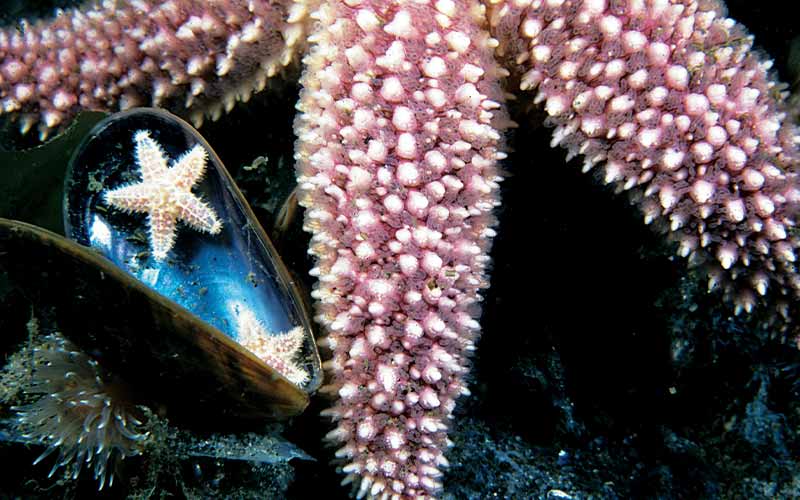
Snorkeling
New Jersey isn’t known for snorkeling, but my wife, Veronica, and I have found a place that works for us. A mile out of Manasquan Inlet is the “2M” buoy, where we’ll often stop to snorkel when the tide is coming in. Sometimes other boaters seem to think we’re crazy or need to be rescued, but if they could see the life below the surface they would think differently. On one particularly memorable day we were surrounded by banded rudderfish the whole time we were in the water, and we were visited by a huge ocean sunfish (Mola mola).
Sightseeing
Sightseeing divers have myriad choices for enjoying the diversity of New Jersey’s marine environment. The show starts with the descent down the anchor line. The surface and the water column offer a never-ending parade of jellyfish, comb jellies, marine snails and plankton. Lion’s mane jellyfish drift past with tiny butterfish seeking shelter in the tentacles. Dinner-plate-shaped, many-ribbed hydromedusae prey on comb jellies for easy meals. Naked sea butterflies use their tiny wings to soar, and comb jellies use their comb rows to oar through the water column while their bodies refract light, providing a multicolored light show.
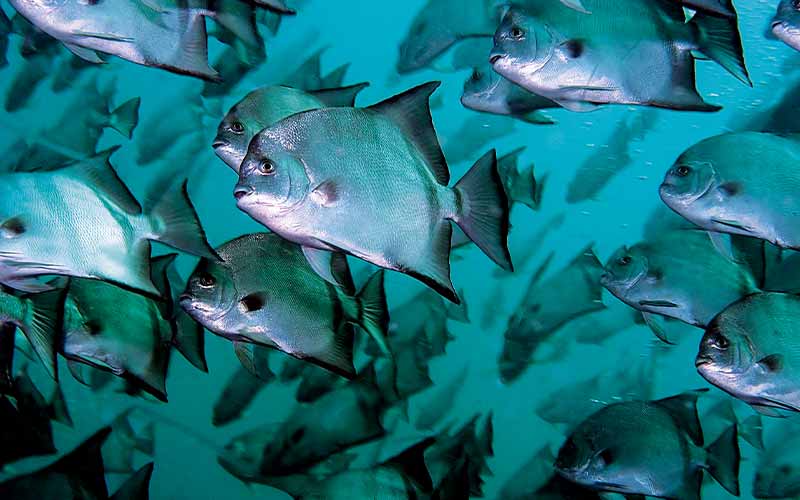
One of the most beautiful places off the New Jersey coast is the spot where two 1850s steam locomotives sit side by side on a sandy, 85-foot bottom off Long Branch, N.J. Because of their historical significance, the locomotives have been “arrested” in federal court in an effort to ensure they remain intact until they can be recovered and restored. The court order prohibits grappling the locomotives, so dive boats must either anchor in the sand or drift.
When I arrive at the locomotives’ coordinates, I mark the spot with an empty milk jug or bleach bottle tied to a weight with enough line to reach the bottom. The area is not known for great visibility, so we’re never sure what we will find. The first time I dived the site, I arrived at the bottom a few feet from the locomotives, and the visibility was about 15 feet. It was the first time I can ever remember standing on the bottom and just staring at the beautiful site before me. The locomotives were covered in frilled and lined anemones, tubularian hydroids and blue mussels. Black sea bass swam in and around the carriages. It was one of the most mesmerizing sights I have seen in all my years diving; I can’t imagine these historical treasures looking any more beautiful than they did that day.
A Tribute
My hands-down favorite dive site is a 110-foot tugboat on the Axel Carlson Reef site. When my wife turned 50, I asked her to pick something special and told her I would get it for her if I could. She chose “a tugboat sunk on the artificial reef and named after me.” My first reaction was, “Don’t make this too hard!” It took three years, but it is now a reality. On Nov. 10, 2004, a McAllister Towing tugboat was named the Veronica M and sent to the bottom. It lies in 75 feet of water, and it’s a haven for marine life. My first visit was in the summer of 2005; the wreck was covered with blue mussels, tubularian hydroids and frilled anemones. Black sea bass, cunner (bergall) and tautog patrolled every part of the Veronica M. The tug is everything my wife hoped it would be and more. This beautiful wreck will provide for its marine inhabitants and surface dwellers for many years, and it will be the final resting place for Veronica and me.
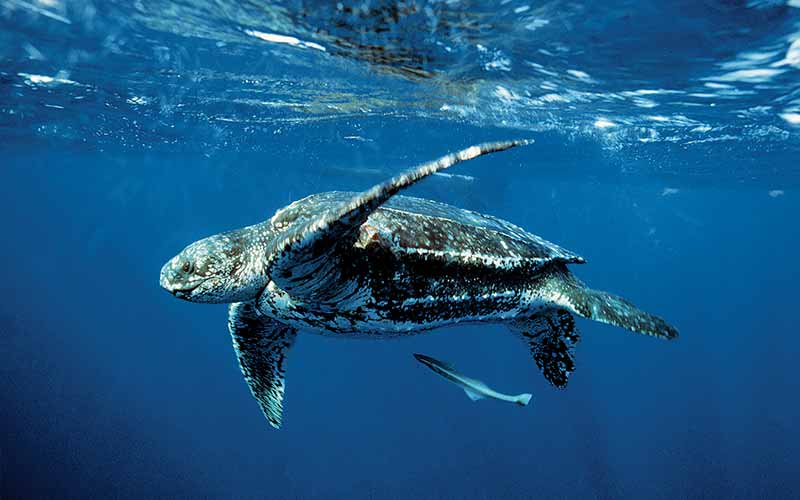
How To Dive It
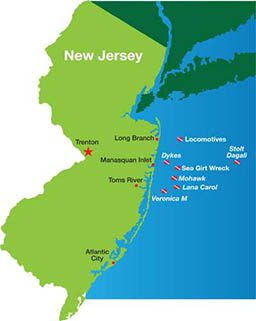
CONDITIONS: Water temperatures range from 37°F in the winter to 70°F in late August and September. Average visibility is 15 to 20 feet, but there are days when it exceeds 50 feet. Visibility is often better on offshore sites. Most wrecks, artificial reefs and rock piles are in 50 to 130 feet of water; many are in the 60- to 90-foot range. A drysuit is recommended, but many divers use 7mm wetsuits.
RECOMMENDED EQUIPMENT: Many N.J. scuba divers use pony tanks with separate regulators, line reels for navigation in low visibility, lift bags for doing safety stops or bringing goodies to the surface, mesh bags for harvesting and dive lights.
GENERAL RECOMMENDATIONS: N.J. diving is not Caribbean diving. When signing up for boat dives, ask the staff about conditions and depths, and make choices to match your skill level.
© Alert Diver — Q4 Fall 2012